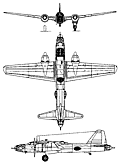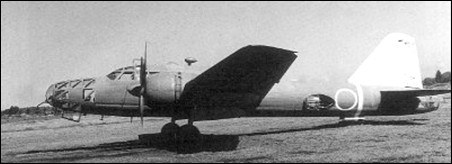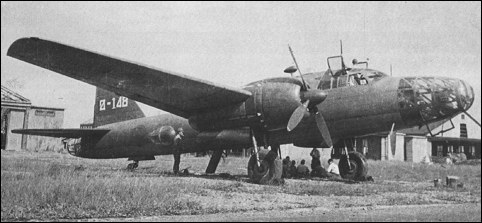|
| Fortunately for the Allies in the latter
stages of the Pacific war, comparatively
few of the formidable Mitsubishi Ki-
67 Hiryu (flying dragon) medium bombers
and torpedo-bombers, codenamed
'Peggy' by air intelligence,
were encountered in action. Production was limited and got off to a late
start in the war, and by the time of its
service debut in 1944 the Ki-67's potency
was negated both by Allied fighter
superiority and by the poor quality of
the JAAF and JNAF crews which operated
it. To take the place of the Mitsubishi
Ki-21 'Sally' and the Nakajima Ki-49 'Helen', the Air Office (Koku Hombu)
issued specifications for a new
bomber to the Mitsubishi concern in
November 1940. The work was led by
Chief Engineer Ozawa on an aircraft
based on the beautiful Japanese lines
and powered by the new generation of
powerful Ha-100 double-row 18-
cylinder radial engines. Three prototypes
of the Ki-67-I were completed
between December 1942 and March
1943, the first making its initial flight on
27 December 1942. The Ki-67-I proved
to be fast (though not as fast as originally
specified), and extremely manoeuvrable
with loops and barrel-rolls
being carried out with ease in an unloaded
configuration. Although
adopted for service as the Army Type
4 Heavy Bomber, such was the promise
of the Ki-67-I that even the Imperial
Japanese Navy was impressed, and
made early representations to Mitsubishi.
On 5 January 1943 Mitsubishi received
an order to convert 100 Ki-49s
as torpedo-bombers, with internal
racks capable of handling the standard
450mm Navy Type 91 Model
II aerial torpedo: these saw service
with the 762nd Kokutai (air group) from
the autumn of 1944 onwards. The Ki-67-
I was issued in small numbers to the
veteran 7th, 14th, 16th, 61st, 62nd, 74th,
98th and 110th Hikosentais (air regiments)
and saw limited action over China,
Biak and Sansapor in north western
New Guinea, and Sumatra in the summer
of 1944. The type was recognized
as such for the first time by the Allies in
October 1944, during the US 3rd
Fleet's attacks on Formosa and the
Ryukyus where the Hiryu served in the
8th Hikoshidan (air division) based on
Formosa under navy control. Thereafter
Ki-67-Is were encountered over the
Philippines, off Iwo Jima, in the strikes
on the US 20th Air Force's bases on
Saipan and Tinian, and in the Okinawa
campaign where it was used as a
suicide aircraft. For suicide missions
the JAAF used modified Peggys
known as the Ki-61-I KAI with armament
removed and a solid nose packed
with explosive. Only two of the
more powerful Ki-67-II variant were
made, production of army and navy
Ki-67-Is amounting to 696. It was the
best Japanese medium bomber of
World War II.

| MODEL | Ki-67 |
| ENGINE | 2 x Army Type 4, 1425kW |
| WEIGHTS |
| Take-off weight | 13765 kg | 30347 lb |
| Empty weight | 8649 kg | 19068 lb |
| DIMENSIONS |
| Wingspan | 22.5 m | 74 ft 10 in |
| Length | 18.7 m | 61 ft 4 in |
| Height | 7.7 m | 25 ft 3 in |
| Wing area | 65.85 m2 | 708.80 sq ft |
| PERFORMANCE |
| Max. speed | 537 km/h | 334 mph |
| Cruise speed | 400 km/h | 249 mph |
| Ceiling | 9470 m | 31050 ft |
| Range w/max.fuel | 3800 km | 2361 miles |
| Range w/max payload | 2800 km | 1740 miles |
| ARMAMENT | 1 x 20mm cannon, 4 x 12.7mm machine-guns, 500-800kg of bombs |
 | A three-view drawing (752 x 1028) |
| Hiroyuki Takeuchi, e-mail, 25.02.2016 14:29 Well written article, but slight correction. The Kamikaze version (To-Go Ki and Sakuradan Ki) did not have " a solid nose packed with explosive" . From the view point of center of gravity this is obvious. The To-Go Ki had 2 800KG bombs in the fuselage and a long detonating fuse stuck ut of the nose. The Sakuradan Ki had a gigantic "Sakuradan" , which emitted explosive gas in the forward direction (same principle as modern day HEAT shell) in mid fuselage. reply | | Hal, e-mail, 10.10.2014 20:36 On my last visit to the SWAP (July 2013), I found a relatively intact Ki-67 . Have photos of it. reply | | Mike, e-mail, 26.03.2013 01:44 About the KI-49. When I say 1 hit wonders I didn't mean she was soft, in fact the KI-49 was also with armor and was designed by the same man who designed the KI-44 Shoki, Dr. Takeo Doi. The problem with the KI-49 was her engines, she didn't have enough power and as a result traveled about 249-259 mph, depending on bomb load. What is worthwhile to note however is that the KI-49 was the first Japanese bomber to have a tail turret.......but better than the KI-67, now way!!!!! reply | | Mike, e-mail, 26.03.2013 01:37 With out a doubt the Mitsubishi KI-67 was the best japanese bomber of the war. Where as the Mitsubishi G4M3 Bomber (Betty) has the most recognition as being the Japanese Bomber of the war......it may of been more numerical, but never better. The KI-67 was designed with the idea of crew safety and it incorporated self sealing fuel tanks right from the start and much better crew armor. She really by size and weight is a medium bomber and not a heavy bomber, oh well! The KI-67 took a long time to come into mased production cause the Koku Hombu (Air Ministry) wanted a bomber, then a tyorpedo plane, then a fighter of different calibers instead of just going forth with the bomber proposal all aslong. With all the delay the KI-67 came into service in time for the Battle of the Phillipinese in 1944 and suffered tremendous losses at tyhew hands of the american fliers. It would of been better for the Japanese to have bought the KI-67 out before the KI-49 Donryu cause all in all the KI-67 was a superior plane from any angle. Where as the Ki-49 was considered slow, and under powered it was also typical of Japanese planes....also known as 1 hit wonders! reply | |
| | Barry, 06.06.2012 12:36 There is no doubt that this was an extremely well designed and capable aeroplane, and that was the problem. The Japanese High Command wanted it to be developed into all sorts of models. Not just the torpedo bomber mentioned above but other considerations included: night fighter, ground attack, and escort fighter. Rather than getting on with the job in hand these vacillations resulted in a delayed entry of the Hiryu into it's original role of heavy bomber. Mind you by allied standards this was not exactly what they would call a heavy bomber. Suffice to say like so many military organisations when the top brass start interfering things can go astray. reply | | Andiez31, 27.08.2011 17:16 Mr.Kucher,
From Wikipedia(Japanese), Imperial Japanese Army ordered 100 Ki-67s with torpedo equipment at Jan /1944.
After that, all Ki-67 can use torpedo (No.161-last)
To be honest my English skill is very poor, but I hope my comment will help you. reply | | K, e-mail, 12.02.2011 13:30 On 5 January 1943 Mitsubishi received an order to convert 100 Ki-49s as torpedo-bombers - does it mean Ki-67s? reply |
|
Do you have any comments?
|
| 
COMPANY
PROFILE
All the World's Rotorcraft
|









